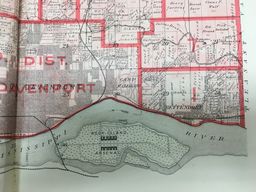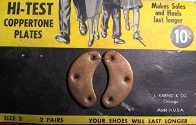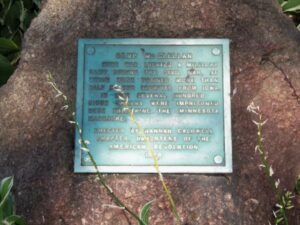
1905 Scott County Atlas Camp McClellan Courtesy of The Rock Island Historical Society
After the Civil War ended, Camp McClellan was abandoned by the military and the land was released back to the Allen family who resided in Missouri. So, this big, wooded area stayed stagnant as the rest of the area continued to develop. This led to two different efforts of conservationists and veterans versus entrepreneurs trying to make something of this area beyond the Village of East Davenport.
Several real estate speculators saw potential for developing this land and many others in the community wanted to see this land become Iowa’s first State Park. However, the Allen family refused to sell.
So, for over 30 years the land sat. The remaining structures decayed, and the barracks, hospital and stockades of the old prison started to fall apart. Some of these last remaining buildings were eventually burned down when squatters moved in and lit fires to stay warm. As nature took over and time passed, the area became known as the Big Woods of Camp McClellan.
Toward the turn of the Century, a Veteran’s organization that knew the significant role Camp McClellan played in the Civil War proposed to the Iowa State Legislature to make Camp McClellan the first state park in Iowa. The head of this movement was John H. MacBride, a conservationist, and Chairman of the Botany Department at the University of Iowa. His group proposed a bill to appropriate $50,000 to secure Camp McClellan as a park. The City of Davenport would match the state funding with an additional $50,000 to acquire the land.
However, at the same time, a developer named Charles S. Reed tracked down the heirs to buy the rights to the area of Camp McClellan. He traveled throughout the U.S. and Europe to find the Allen Family Heirs and by November 1st, 1903 he reached his goal. He convinced an interested financier named Wettstein to help invest in buying the former Camp McClellan with a treasurer from the John D. Rockefeller’s Standard Oil Co.
Reed was not about to let this area go for $100,000 as a State Park. He told the Davenport Businessmen’s Association the land was worth almost $1 million if it was compared to lots in other parts of the City. However, he was willing to sell a 40-acre tract occupied by the Union troops for $100,000. This would include the oval block between Ridgewood Avenue, Hillcrest Avenue and McClellan Boulevard where the barracks had stood. He also proposed a 50 ft. high monument providing a view of 15 miles. This monument was never built and the dream of a state park faded away.
However, by 1910 Reed grew tired of fighting and sold out his part of the partnership. The remaining partner said all agreements were null and void, because it was Reed who developed the agreement. So, the land needed to be auctioned. This prospect scared the community of the Village of East Davenport who was not about to let factories come near their Village. So, they rushed to buy part of the land closest to their Village through fundraising. The Village asked each child to raise $1 and each adult to raise $5 to buy the land. In the end, they were successful in acquiring the land. The Lindsay Family sold the lower part to the city at a reduced price, so it could become a municipal park. The two parts were then united, and the city owned the entire park. Today there is a small plaque commemorating the Civil War heritage in this area named Lindsay Park.
Did You Know?

Once Camp McClellan was disbanded, this area went back to the big woods. The kids who lived on the edge of this area would play in these woods. Well, there was so much stuff left behind by the remains of the Camp that these kids quickly wore out their shoes. So, the shoemaker in the Village of East Davenport devised copper toe guards on each of the children’s shoes, so their shoes would last longer. This picture probably is not what the shoemaker devised to protect the children. How do you think these shoes looked?
This shoemaker was well ahead of his time. The first steel-toe boots were actually developed in the 1930s by the Red Wing Shoe Company. These shoes were invented for both military and industrial workers.


